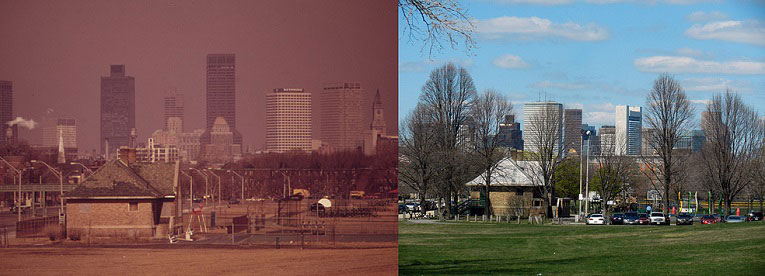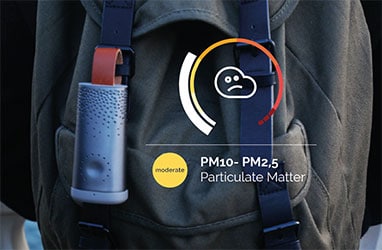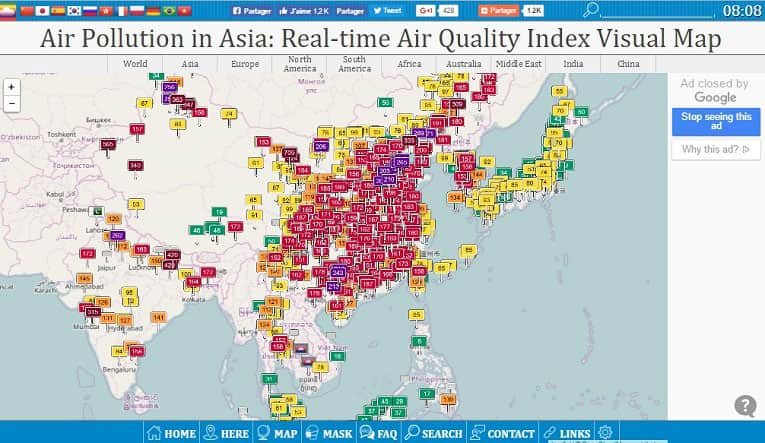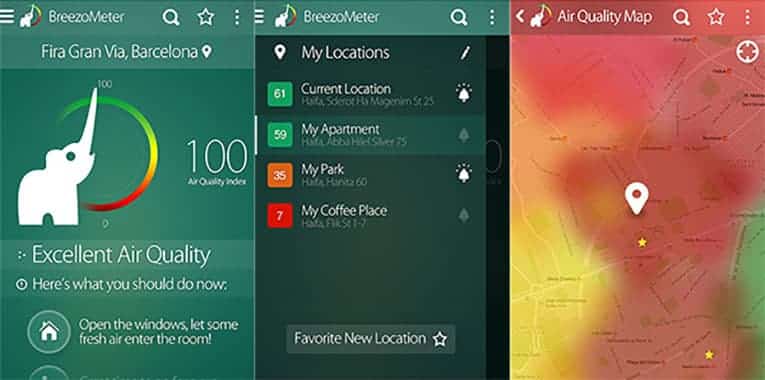Why Open Data is a Powerful Tool in the Struggle for Cleaner Air

This blog post gives an overview of how low-cost sensors, mobile apps, and open data platforms are helping citizens, researchers and policy-makers alike to better understand the nature, impact and state of air quality.
Alex was busy planting a new hedge in her front yard when a neighbor delivered some surprising advice: be careful digging in the dirt, it may still be contaminated. Unknown to Alex, the 1940s Pacific Northwest bungalow she and her husband Bryce bought in 2014 stood in the bygone shadows of the ASARCO copper smelt smokestack, once the tallest structure in the West. Shut down in 1985 and demolished in 1993, the smokestack produced a 1000 square-mile plume of lead, arsenic and sulfur dioxide that saturated the air for several decades, and whose toxic presence lingers on in the area’s soil to this day.
Fortunately Alex and Bryce’s yard soon entered the queue for one of the successive waves of soil replacement programs that have taken place in the area. The progress made to date in cleaning the air and soil in the region mirrors improvements across the U.S. since the creation of the Environmental Protection Agency in 1970, and a strengthening of the Clean Air Act in that same year.
In fact, according to the report “State of the Global Air 2017” from the Health Effects Institute, The Institute for Health Metrics and Evaluation and the University of British Columbia, the U.S. saw a 27% reduction in exposure to the most damaging type of pollution, particulate matter (PM) (specks of dust, soot, dirt, smoke, and liquid droplets), in the period from 1990 to 2015, building on improvements made over the prior two decades. Over the extended period from 1970 to 2007, the gains were even more impressive, with an average reduction of more than 50 percent of the six most common air pollutants, and a 70 percent reduction in toxic emissions from large industrial sources (see the EPA’s Plain English Guide to the Clean Air Act).

However, many US cities continue to have days in which air pollution reaches unhealthy levels. The same applies to cities in other countries where overall air quality has improved. In some cases, the breeches can be dramatic. London, for example, breached its target annual air pollution limit for the entire year in just the first five days of 2017.
The Battle Against Air Pollution: Uneven Progress, Heightened Attention
The air quality crisis in London brought a wave of media attention to air pollution, with air quality stories garnering unusual front page coverage in the UK. Crises in China and other regions also generated much media attention, as did the State of the Global Air 2017 report and a major report from the World Bank and Institute for Health Metrics and Evaluation.
@guardiancities Taken last November mid morning here in Delhi. Only when this extreme did it become a (minor) political issue…for a week. pic.twitter.com/aVd0snXhuP
— Sebastian Taylor (@DilliSeb) 13 février 2017
The World Bank report found the total global cost of premature deaths and illness due to air pollution to be $5T, including $225B annually in lost labor costs alone. The Health Effects Institute report highlighted an increase in premature deaths from 3.5 million in 1990 to 4.2 million in 2015 for outdoor pollution alone (6.5 million for combined indoor and outdoor pollution), with exposure carrying a higher risk of early death than smoking, diet, and high blood pressure, and contributing to a wide range of ailments from heart and lung disease to miscarriage, premature birth, and negative impacts on the intellectual and physical development of children.
The report also showed that while the air in high-income countries had become cleaner, conditions had worsened in low- and middle-income countries, including a serious deterioration in some countries like Bangladesh and India.
But amidst the bleak news carried by recent reports comes a hopeful sign. The reports, and possible solutions to conditions they detail, were made possible because governments and organizations around the world have been sharing the air-quality-related data they collect, making it open and accessible to all in the fight against air pollution. And now, technology advances are paving the way for gathering and sharing more comprehensive, accurate and timely data, with potential benefits on many levels.
Open Data: A Key Role Now and in the Future
To date most air pollution data has been derived from models based on data from a limited number of stationary monitoring sites combined with transportation, weather data, satellite imaging data and other open data sources to estimate pollution for various locations. To improve the accuracy of these models, more direct air quality data is needed.
Now, gathering that data is becoming feasible. Low-cost portable sensing devices connected via WiFi networks are available today at a fraction of the cost of conventional stationary systems, enabling localities to greatly expand the number of monitoring points.
At the upper end of the scale are sensors (often multi-purpose) that can be attached to lampposts, bus stops, buildings, utility poles and other fixtures. At the lower end are affordable personal sensor devices that enable residents and visitors to participate in gathering and sharing air quality data. These personal devices can be placed in homes or workplaces, or carried as one walks or bikes to gather ambulatory measurements.

An example is Plume Labs Flow. It’s a small, portable device that can be used indoors or outdoors. It provides direct readings to the user, and transmits data to the Plume Air Cloud. The cloud platform aggregates real-time data from Flow devices with data with other open data sources from 350+ cities, and makes that aggregate data available through an open data API (Application Programming Interface) that allows software programs to interact with the data.
Plume Labs also provides a free mobile application that uses open data and artificial intelligence to provide highly-localized air quality forecasts via iOS, Watch and Android devices. There are dozens of start-ups, civic technology organizations, NGOs and large technology vendors that, like Plume, are providing one or more products in this range of 1) low cost portable sensors, 2) mobile applications and 3) data sharing platforms. Each brings unique benefits to the battle against air pollution.

Low Cost Sensors
As noted, the development of low-cost sensors is making it feasible to fill in coverage gaps in monitoring, and hence to provide real world data to improve the accuracy of air quality assessment and forecasting models. When personal portable devices are added to the mix, the data points can become highly localized.
This localization can be very valuable in helping to pinpoint pollution-emitting sources so improvements can be made. The breadth of coverage is also invaluable to assessing the effectiveness of pollution reduction programs.
The use of personal sensors also delivers a citizen-awareness benefit, providing direct feedback about air quality to the user. It also encourages civic engagement as individuals contribute to the greater project of creating cleaner, healthier, more livable communities.
These benefits, are dependent however, on data being aggregated from personal and public sensors, and shared. And this is where open data publishing and sharing platforms come in.
Open Data Sharing Platforms
Open data sharing platforms differ in features and functionalities, but all make the data they provide available to anyone to use and reuse without restrictions. They also provide the data in machine-readable formats (structured data files or APIs). These platforms exist at local, regional and national levels, with publicly and privately funded portals in turn creating international portals by aggregating data from other portals
Open Data for Research
One of the primary purposes of these portals at all levels is to support scientific and policy research on air quality. One example of such a portal at the international level is OpenAQ. To date, the OpenAQ platform provides raw sensor data from 5,430 locations in 46 countries. The data is available as downloadable data sets and API feeds. The platform provides community-based support to researchers and scientists, and encourages software developers, educators, and journalists in their use of open air quality data as well.
Open Data for Advocacy and Awareness
Another global portal is the World Air Quality Index. It provides real-time city- and country-level air quality metrics derived from data from more than 70 countries, including data from 9000 stations in 800 major cities. It makes this data available as dashboards and API feeds from two websites (aqicn.org and waqi.info). Its mission is to promote air pollution awareness and uniform global metrics. Advocacy and awareness are also important missions of local, regional and national portals.

Open Data for Program Evaluation
Another open data benefit as mentioned previously is the ability to evaluate the effectiveness of pollution reduction programs. This is an important platform use case at all levels. While many broad measures touching on environmental regulations, energy policy, transportation planning and urban planning have generally proved to be effective at reducing pollution, precise analyses of the nature and extent of program impacts depends on multidisciplinary access to the greatest possible depth of data.

Architect Stefano Boeri has proposed vertical gardens to combat pollution in Chinese cities. Access to open sensor data could be used to evaluate the effectiveness of trials before larger rollouts. Here: Nanjing Green Towers, promoted by Nanjing Yang Zi State-owned National Investment Group Co. ltd. as the first Vertical Forest to be built in Asia. Image: © Stefano Boeri Architetti
Open Data for Civic Technology & Citizen Science
Open data platforms are also essential for engaging citizen volunteers in the fight against air pollution. It supports the kind of engagement represented by, for example, the open data Institute’s #AirHack event in Leeds. Working with local datasets, that event gathered more than 100 volunteers to explore how they could use open data to address challenges such as increasing citizen engagement in air quality issues.
As the group pondered on their website: “With open data, everyone can be involved. Instead of relying on data scientists based in local councils or organisations, could local people help crunch numbers, gather data, make changes, tell data stories? What should we be measuring? What are we actually breathing every day?”
Our team are @ODILeeds‘ #AirHack contributing to open data-driven #AirPollution discussions & solutions. #AirQuality #OpenData pic.twitter.com/R4eCjvJoyX
— DATA MILL NORTH (@DataMillNorth) 24 février 2017
Open Data for Education
Open data platforms for air quality are also being used in schools and universities to gain skills in science, technology, engineering, and math as students learn about air quality challenges, and perhaps find new solutions as well.
Open Data to Stimulate Economic Activity
Finally, open data platforms can both support economic activity, or serve as a source of economic activity in and of themselves. In the case of the latter, some start-up companies are gathering and enriching open data, and offering two-tiered access to it: free, and premium. This is the case for Plume Labs, whose Plume Air Cloud offers free, unrestricted access to real time air quality data, and paid access to forecast data that it develops with proprietary AI techniques.
For the former, some companies provide custom development of dashboards or software programs using open air quality data, or they use the open APIs to develop mobile applications supported by subscriptions or advertising fees. Many mobile air quality applications, however, are developed by civic tech volunteers and offered at no cost.
Mobile Applications
BreezoMeter is one company that offers paid APIs, professional services and a free mobile app. BreezoMeter enhances open air quality data with big data sources (weather, satellite and traffic data) and machine learning techniques to develop and deliver accurate local information in real time via their API and their free mobile application.

The free mobile app provides a friendly introduction to the company and its commercial products and services, and it illustrates the benefits of mobile apps, whether free or paid, that use open air quality data. These benefits include:
- Healthier Living: The app helps people plan activities and routes around current air quality conditions. While this is of benefit to everyone, it is of special value to those with asthma, allergies or other respiratory conditions. And if a stage is reached where apps like this one are commonplace, it can improve transportation-related air quality for all citizens: if enough travelers alter their routes to avoid pollution hot spots, those hot spots will cool down.
- Citizen Awareness & Engagement: A second major benefit is citizen awareness of conditions in their community. The more the population is aware of air quality problems, the more likely they are to translate their concerns into modified behaviors, and political engagement. They can also be of help in identifying particular trouble spots or pollution sources that may never surface without ‘boots on the ground’ making discoveries.
Open Data + Air Pollution Data = A Winning Formula
Air quality mobile apps like BreezoMeter along with open air quality data platforms and low-cost portable sensors are helping citizens, researchers and policy-makers alike better understand the nature, impact and state of air quality around the corner and around the globe.
Outdoor air quality, Downtown L.A.: 16 micrograms of PM2.5 per cubic meter; 532 ppm of CO2; 65% humidity; moderate AQI of 59 pic.twitter.com/8XSNEn7s7C
— Nate Berg (@nate_berg) 10 février 2017
The knowledge, behavioral changes and policy improvements these open ecosystems of data and sensors are yielding are having a positive impact on communities today, and this impact will only grow as these ecosystems spread across the globe.
Certainly, the world will never be free of air pollution. It has natural causes (volcano eruptions, forest fires, wind erosion, etc.), and major changes like transitioning away from fossil fuels have to be effected.
But progress can and will happen. The open air quality data genie is out of the bottle. Even if policy makers come along that try to impede air pollution monitoring efforts, there are enough agile sensors, citizen apps and distributed data networks in place to keep the momentum going.
Consider, for a moment the tale of Spanish architect Nerea Calvillo as told in Ellis O’Neill’s Broken Toilets magazine (which also by the way tells the story of the OpenAQ founders, and provides a nice summary of the EPA’s open air quality data success story).
A Lesson from Madrid
Calvillo launched an open air quality data project, “In the Air,” that she hoped “would raise awareness and become a platform for political action against air pollution.” She aggregated air quality data from 24 municipal monitors in Madrid and built a live visualization of the data on her website.
One day, the visualization stopped working. She discovered the City had moved some of the monitors from pollution hotspots to green spaces, and gotten rid of others. It seems they were aiming to boost the City’s odds of complying with EU air quality regulations. The discovery led to a political scandal that played out in the press – and brought public awareness to the issue of air pollution.
The City did not put the stations back, but Calvillo did accomplish her goal of public awareness, and with the right partners, low-cost mobile sensors could probably be deployed to fill the coverage gaps. (And yes, her visualization is back online)
While O’Neill notes that neither Calvillo nor the others he talked to felt like they’d really made the leap from community action to bringing about major policy changes, that tide may be turning with the recent wave of global media attention on air pollution, aided by a growing multitudes of citizen activists collecting and sharing data – in their communities and on social media.
With the right combination of political will, open data and sound public policy, the battle for clean air is a winnable one.
 Data Trends
Data Trends
How successful are governments at sharing their data with citizens and businesses? The latest Open Data Maturity report provides an overview of progress across Europe, and highlights the importance of improving data portals and measuring impact to future success

Data drives effective, well-functioning smart cities and helps build local ecosystems that bring together all stakeholders to meet the needs of the entire community. However, sharing data between stakeholders can be difficult - based on recent Gartner research we explain how urban data exchanges transform smart city data sharing.

